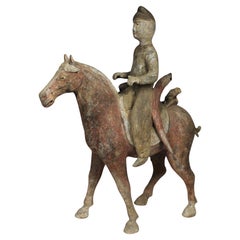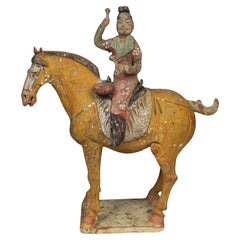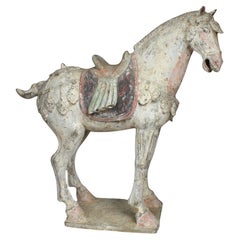About Your Antiquarian
Your Antiquarian offer ancient art and ancient coins for sale. Our main objective is the sale of ancient art and ancient coins offering the highest quality at the best price respecting and strictly complying with the laws of heritage protection and UNESCO’s heritage norms. Therefore, all the pieces are purchased from private collections in which the provenance can be checked or international auctions. All our antiquities and coins are accompanied by their Certificate of Authenticity. We have a no quibble 90 days return policy. At Your Antiquarian we are committed to help...Read More

Established in 20111stDibs seller since 2022
Featured Pieces
Chinese statuette of a horse with rider
Located in EL CAMPELLO, ES
ITEM: Statuette of a horse with rider
MATERIAL: Pottery
CULTURE: Chinese, Tang Dynasty
PERIOD: 618 – 907 A.D
DIMENSIONS: 520 mm x 420 mm x 180 mm
CONDITION: Good condition. Includes ...
Category
Antique 15th Century and Earlier Chinese Tang Antiquities
Materials
Pottery
Chinese statuette of a horse with musician
Located in EL CAMPELLO, ES
ITEM: Statuette of a horse with musician
MATERIAL: Pottery
CULTURE: Chinese, Tang Dynasty
PERIOD: 618 – 907 A.D
DIMENSIONS: 420 mm x 365 mm x 145 mm
CONDITION: Good condition. Includ...
Category
Antique 15th Century and Earlier Chinese Tang Antiquities
Materials
Pottery
Chinese statuette of a Sogdian rider
Located in EL CAMPELLO, ES
ITEM: Statuette of a Sogdian rider
MATERIAL: Pottery
CULTURE: Chinese, Tang Dynasty
PERIOD: 618 – 907 A.D
DIMENSIONS: 560 mm x 510 mm x 175 mm
CONDITION: Good condition. Includes The...
Category
Antique 15th Century and Earlier Chinese Tang Antiquities
Materials
Pottery
Chinese statuette of a horse
Located in EL CAMPELLO, ES
ITEM: Statuette of a horse
MATERIAL: Pottery
CULTURE: Chinese, Tang Dynasty
PERIOD: 618 – 907 A.D
DIMENSIONS: 560 mm x 530 mm x 200 mm
CONDITION: Good condition. Includes Thermolumin...
Category
Antique 15th Century and Earlier Chinese Tang Antiquities
Materials
Pottery
Chinese statuette of a horse
Located in EL CAMPELLO, ES
ITEM: Statuette of a horse
MATERIAL: Pottery
CULTURE: Chinese, Northern Wei Dynasty
PERIOD: 386 – 535 A.D
DIMENSIONS: 404 mm x 350 mm x 230 mm
CONDITION: Good condition. Includes Th...
Category
Antique 15th Century and Earlier Chinese Tang Antiquities
Materials
Pottery
Egyptian scarab as a commemorative of Ramesses II or prenomen of Shoshenq III
Located in EL CAMPELLO, ES
ITEM: Scarab as a commemorative of Ramesses II or prenomen of Shoshenq III
MATERIAL: Black steatite
CULTURE: Egyptian
PERIOD: New Kingdom to Third Intermediate Period, 1279 – 664 B.C...
Category
Antique 15th Century and Earlier Egyptian Egyptian Antiquities
Materials
Stone
Scarab with prenomen for Amenhotep II
Located in EL CAMPELLO, ES
ITEM: Scarab with prenomen for Amenhotep II
MATERIAL: Steatite
CULTURE: Egyptian
PERIOD: New Kingdom, XVIIIth Dynasty, 1143 – 1417 B.C
DIMENSIONS: 15 mm x 11 mm
CONDITION: Good condition
PROVENANCE: Ex American egyptologist collection, active in the early part of the 20th century, brought to the US with the family in 1954.
Comes with Certificate of Authenticity and Export Licence. If you are from outside the European Union, we will have to apply for the export licence again for your country, this takes 4 to 6 weeks.
Amenhotep II, the seventh pharaoh of the 18th Dynasty of ancient Egypt, ruled during the New Kingdom period around the 15th century BCE. Renowned for his military prowess, Amenhotep II expanded the Egyptian empire through numerous campaigns, solidifying control over territories in Nubia and the Levant. His expeditions into Syria and Canaan, notably the Battle of Megiddo, showcased his strategic acumen as he secured victories against local rebellions and coalitions, leaving behind inscriptions and reliefs that celebrated his triumphs.
Beyond his military endeavors, Amenhotep II also left a mark through his architectural projects, albeit less pronounced compared to other pharaohs. He oversaw the construction of temples and monuments across Egypt, contributing to the cultural landscape of the time. Additionally, Amenhotep II was known for his personal interests in sports and physical activities, with depictions showcasing him engaging in hunting, chariot racing, and archery, reflecting the pursuits of Egyptian nobility and emphasizing the ideal of the warrior-king.
While Amenhotep II's reign brought stability and prosperity to Egypt, his legacy is overshadowed by some of his predecessors and successors. Despite his military successes and contributions to Egyptian architecture, he is not as widely celebrated as figures like Thutmose III or Ramses II.
Category
Antique 15th Century and Earlier Egyptian Egyptian Antiquities
Materials
Stone
Egyptian scarab with spiral design
Located in EL CAMPELLO, ES
ITEM: Scarab with spiral design
MATERIAL: Steatite
CULTURE: Egyptian
PERIOD: Second Intermediate Period, 1700 – 1550 B.C
DIMENSIONS: 12 mm x 9 mm
CONDITION: Good condition
PROVENANCE...
Category
Antique 15th Century and Earlier Egyptian Egyptian Antiquities
Materials
Stone
Egyptian scarab with pseudo-hieroglyphic, Anra-type
Located in EL CAMPELLO, ES
ITEM: Scarab with pseudo-hieroglyphic, Anra-type
MATERIAL: Steatite
CULTURE: Egyptian
PERIOD: Second Intermediate Period, 1700 – 1550 B.C
DIMENSIONS: 10 mm x 15 mm
CONDITION: Good co...
Category
Antique 15th Century and Earlier Egyptian Egyptian Antiquities
Materials
Stone
Egyptian scarab with Uraeus, Ankh and neb basket (Amun trigram)
Located in EL CAMPELLO, ES
ITEM: Scarab with Uraeus, Ankh and neb basket (Amun trigram)
MATERIAL: Steatite
CULTURE: Egyptian
PERIOD: New Kingdom, 1550 – 1070 B.C
DIMENSIONS: 12 mm x 8 mm
CONDITION: Good condit...
Category
Antique 15th Century and Earlier Egyptian Egyptian Antiquities
Materials
Stone
Chinese statuette of a Fat Lady
Located in EL CAMPELLO, ES
ITEM: Statuette of a Fat Lady
MATERIAL: Pottery
CULTURE: Chinese, Tang Dynasty
PERIOD: 618 – 907 A.D
DIMENSIONS: 645 mm x 260 mm x 180 mm
CONDITION: Good condition. Includes Thermoluminescence test by Laboratory Kotalla (Reference 04B101123). Includes Certificate of Authenticity from Dutch gallery
PROVENANCE: Ex Belgian private collection, acquired from Dutch art gallery
Comes with Certificate of Authenticity and Export Licence. If you are from outside the European Union, we will have to apply for the export licence again for your country, this takes 4 to 6 weeks.
Due to the fragility and size of this piece, it can only be shipped within the European Union, United Kingdom and neighbouring countries that can be transported by road by private courier (door to door).
This beautifully-finished ceramic attendant was made during what many consider to be China’s Golden Age, the Tang Dynasty. It was at this point that China’s outstanding technological and aesthetic achievements opened to external influences, resulting in the introduction of numerous new forms of self-expression, coupled with internal innovation and considerable social freedom. The Tang dynasty also saw the birth of the printed novel, significant musical and theatrical heritage and many of China’s best- known painters and artists.
The Tang Dynasty was created on the 18th of June, 618 AD, when the Li family seized power from the last crumbling remnants of the preceding Sui Dynasty. This political and regal regime was long-lived, and lasted for almost 300 years. The imperial aspirations of the preceding periods and early Tang leaders led to unprecedented wealth, resulting in considerable socioeconomic stability, the development of trade networks and vast urbanisation for China’s exploding population (estimated at around 50 million people in the 8th century AD). The Tang rulers took cues from earlier periods, maintaining many of their administrative structures and systems intact. Even when dynastic and governmental institutions withdrew from management of the empire towards the end of the period – their authority undermined by localised rebellions and regional governors known as jiedushi –the systems were so well- established that they continued to operate regardless.
The artworks created during this era are among China’s greatest cultural achievements. It was the greatest age for Chinese poetry and painting, and sculpture also developed (although there was a notable decline in Buddhist sculptures following repression of the faith by pro-Taoism administrations later in the regime). It is disarming to note that the eventual decline of imperial power, followed by the official end of the dynasty on the 4th of June 907, hardly affected the great artistic turnover.
During the Tang Dynasty, restrictions were placed on the number of objects that could be included in tombs, an amount determined by an individual’s social rank. In spite of the limitations, a striking variety of tomb furnishings – known as mingqi – have been excavated. Entire retinues of ceramic figures – representing warriors, animals, entertainers, musicians, guardians and every other necessary category of assistant – were buried with the dead in order to provide for the afterlife. Warriors (lokapala) were put in place to defend the dead, while horses/ camels were provided for transport, and officials to run his estate in the hereafter. Of all the various types of mingqi, however, there are none more elegant or charming than the sculptures of sophisticated female courtiers, known – rather unfairly – as “fat ladies...
Category
Antique 15th Century and Earlier Chinese Tang Antiquities
Materials
Pottery
Chinese statuette of a Fat Lady
Located in EL CAMPELLO, ES
ITEM: Statuette of a Fat Lady
MATERIAL: Pottery
CULTURE: Chinese, Tang Dynasty
PERIOD: 618 – 907 A.D
DIMENSIONS: 655 mm x 265 mm x 210 mm
CONDITION: Good condition. Includes Thermoluminescence test by Laboratory Kotalla (Reference 05B101123). Includes Certificate of Authenticity from Dutch gallery
PROVENANCE: Ex Belgian private collection, acquired from Dutch art gallery
Comes with Certificate of Authenticity and Export Licence. If you are from outside the European Union, we will have to apply for the export licence again for your country, this takes 4 to 6 weeks.
Due to the fragility and size of this piece, it can only be shipped within the European Union, United Kingdom and neighbouring countries that can be transported by road by private courier (door to door).
This beautifully-finished ceramic attendant was made during what many consider to be China’s Golden Age, the Tang Dynasty. It was at this point that China’s outstanding technological and aesthetic achievements opened to external influences, resulting in the introduction of numerous new forms of self-expression, coupled with internal innovation and considerable social freedom. The Tang dynasty also saw the birth of the printed novel, significant musical and theatrical heritage and many of China’s best- known painters and artists.
The Tang Dynasty was created on the 18th of June, 618 AD, when the Li family seized power from the last crumbling remnants of the preceding Sui Dynasty. This political and regal regime was long-lived, and lasted for almost 300 years. The imperial aspirations of the preceding periods and early Tang leaders led to unprecedented wealth, resulting in considerable socioeconomic stability, the development of trade networks and vast urbanisation for China’s exploding population (estimated at around 50 million people in the 8th century AD). The Tang rulers took cues from earlier periods, maintaining many of their administrative structures and systems intact. Even when dynastic and governmental institutions withdrew from management of the empire towards the end of the period – their authority undermined by localised rebellions and regional governors known as jiedushi –the systems were so well- established that they continued to operate regardless.
The artworks created during this era are among China’s greatest cultural achievements. It was the greatest age for Chinese poetry and painting, and sculpture also developed (although there was a notable decline in Buddhist sculptures following repression of the faith by pro-Taoism administrations later in the regime). It is disarming to note that the eventual decline of imperial power, followed by the official end of the dynasty on the 4th of June 907, hardly affected the great artistic turnover.
During the Tang Dynasty, restrictions were placed on the number of objects that could be included in tombs, an amount determined by an individual’s social rank. In spite of the limitations, a striking variety of tomb furnishings – known as mingqi – have been excavated. Entire retinues of ceramic figures – representing warriors, animals, entertainers, musicians, guardians and every other necessary category of assistant – were buried with the dead in order to provide for the afterlife. Warriors (lokapala) were put in place to defend the dead, while horses/ camels were provided for transport, and officials to run his estate in the hereafter. Of all the various types of mingqi, however, there are none more elegant or charming than the sculptures of sophisticated female courtiers, known – rather unfairly – as “fat ladies...
Category
Antique 15th Century and Earlier Chinese Tang Antiquities
Materials
Pottery



